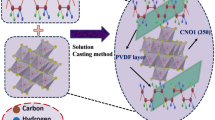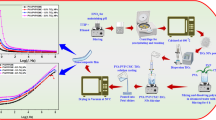Abstract
Because of their enormous potential for use in current electronic systems, polymer-based dielectric materials have garnered considerable attention. The spatial distribution of fillers has a significant impact on the dielectric behavior of polymer composites, so a better understanding of the relationship between the dielectric properties of composites and the spatial distribution of filler would be extremely helpful in developing new high-performance dielectrics. In this study, anatase TiO2 and hexagonal boron nitride (h-BN) nanocomposites were prepared by ball-milling. This was followed by the preparation of poly(vinylidene fluoride)–co-hexafluoropropylene (PVDF-HFP)-based polymer nanocomposites. TiO2/h-BN material was confirmed by x-ray diffraction (XRD) analysis. The TiO2/h-BN nanoparticles were well distributed in scanning electron microscopy (SEM) images, with very little particle aggregation. The Fourier transform infrared (FTIR) spectroscopy data indicate that the nanocomposite components interact well. AC impedance spectroscopy was used to investigate the variations in electrical characteristics including dielectric constant, dielectric loss and electrical resistivity (Nyquist plot) of the prepared composite film. These films were applied to enhance load-bearing capacity during electrostatic force state, making use of flexible fabric-based metal electrodes. The load-bearing capacity of the film was determined by measuring the tensile strength. The PVDF-HFP/TiO2/h-BN nanocomposite showed flexibility in addition to dependable dielectric capabilities, making it potentially suitable for a variety of flexible electronic devices such as electroadhesion and electrostatic storage devices.










Similar content being viewed by others
Data Availability
The data will be available upon request from the authors.
References
C. Wang, J. Zhang, S. Gong, and K. Ren, Significantly enhanced breakdown field for core-shell structured poly (vinylidene fluoride-hexafluoropropylene)/TiO2 nanocomposites for ultra-high energy density capacitor applications. J. Appl. Phys. 124, 154103 (2018).
S. Liu, S. Xue, W. Zhang, J. Zhai, and G. Chen, Significantly enhanced dielectric property in PVDF nanocomposites flexible films through a small loading of surface-hydroxylated Ba0.6Sr0.4 TiO3 nanotubes. J Mater Chem A 2(42), 18040–18046 (2014).
E. Huang, J. Zhao, J. Zha, L. Zhang, R. Liao, and Z. Dang, Preparation and wide-frequency dielectric properties of (Ba0.5Sr0.4Ca0.1) TiO3/poly (vinylidene fluoride) composites. J. Appl. Phys. 115, 194102 (2014).
A. Facchetti, M.H. Yoon, and T.J. Marks, Gate dielectrics for organic field-effect transistors: new opportunities for organic electronics. Adv. Mater. 17, 1705 (2005).
Q. Zhang, H. Li, M. Poh, F. Xia, Z. Cheng, and H. Xu, An all-organic composite actuator material with a high dielectric constant. Nature 419, 284 (2002).
Y. Bai, Z. Cheng, V. Bharti, H. Xu, and Q. Zhang, High-dielectric-constant ceramic-powder polymer composites. Appl. Phys. Lett. 76, 3804 (2000).
A. Burke, R&D considerations for the performance and application of electrochemical capacitors. Electrochim. Acta 53, 1083 (2007).
M. Crippa, A. Bianchi, D. Cristofori, M. D’Arienzo, F. Merletti, F. Morazzoni, R. Scottia, and R. Simonutti, High dielectric constant rutile–polystyrene compositewith enhanced percolative threshold. J. Mater. Chem. C 1, 484 (2013).
B. Balasubramanian, K.L. Kraemer, N.A. Reding, R. Skomski, S. Ducharme, and D.J. Sellmyer, Synthesis of monodisperse TiO2−paraffin core−shell nanoparticles for improved dielectric properties. ACS Nano 4(4), 1893–1900 (2010).
B. Chu, M. Lin, B. Neese, and Q. Zhang, Interfaces in poly(vinylidene fluoride) terpolymer/ZrO2 nanocomposites and their effect on dielectric properties. J. Appl. Phys. 105, 14103 (2009).
J. Xu and C. Wong, Characterization and properties of an organic–inorganic dielectric nanocomposite for embedded decoupling capacitor applications. Compos Part A 38, 13 (2006).
Y. Lin, C. Bunker, K. Fernando, and J. Connell, Aqueously dispersed silver nanoparticle-decorated boron nitride Nanosheets for reusable, thermal oxidation-resistant surface enhanced Raman spectroscopy (SERS) devices. ACS Appl. Mater. Interfaces 4, 1110–1117 (2012).
G. Doll, J. Speck, G. Dresselhaus, M. Dresselhaus, K. Nakamura, and S. Tanuma, Intercalation of hexagonal boron nitride with potassium. J. Appl. Phys. 66, 2554–2558 (1989).
K. Zhang, Y. Feng, F. Wang, Z. Yang, and J. Wang, Two dimensional hexagonal boron nitride (2D-hBN): synthesis, properties and applications. J Mater Chem C 5(46), 11992–12022 (2017).
H. Jiang and J. Lin, Hexagonal boron nitride for deep ultraviolet photonic devices. Semicond. Sci. Technol. 29, 084003 (2014).
F. Hui, C. Pan, Y. Shi, Y. Ji, E. Grustan-Gutierrez, and M. Lanza, On the use of two dimensional hexagonal boron nitride as dielectric. Microelectron. Eng. 163, 119–133 (2016).
G. Constantinescu and N. Hine, Multipurpose black-Phosphorus/hBNHeterostructures. NanoLett. 16, 2586–2594 (2016).
J. Bao, M. Edwards, S. Huang, Y. Zhang, Y. Fu, X. Lu, Z. Yuan, K. Jeppson, and J. Liu, Thermal conduction across a boron nitride and SiO2 interface. J. Phys. D Appl. Phys. 49, 265501 (2016).
K. Oh, D. Lee, M. Choo, K. Park, S. Jeon, S. Hong, J. Park, and J. Choi, Enhanced durability of polymer electrolyte membrane fuel cells by functionalized 2D boron nitride Nanoflakes. ACS Appl. Mater. Interfaces 6, 7751–7758 (2014).
D. Chimene, D. Alge, and A. Gaharwar, Two-dimensional nanomaterials for biomedical applications: emerging trends and future prospects. Adv. Mater. 27, 7261–7284 (2015).
Z. Huanga and W. Zhao, Coupling hybrid of HBN nanosheets and TiO2 to enhance the mechanicaland tribological properties of composite coatings. Prog. Org. Coat. 148, 105881 (2020).
D. Ponnamma and M. Al-Maadeed, Influence of BaTiO3/white graphene filler synergy on the energy harvestingperformance of piezoelectric polymer nanocomposite. Sustain Energy Fuels 3, 774–785 (2019).
G. Rana, C. Johri, and K. Asokan, Correlation between structural and dielectric properties of Ni-substituted magnetite Nanoparticles. Europhys. Lett. 103, 17008 (2013).
S. Khalate, R. Kate, H. Pathan, and R. Deokate, Structural and electrochemical properties of spray depositedmolybdenum trioxide (α-MoO3) thin films. J. Solid State Electrochem. 21, 2737–2746 (2017).
Z.M. Dang, M.S. Zheng, and J.W. Zha, 1D/2D carbon nanomaterial-polymer dielectric composites with high permittivity for power energy storage applications. Small 12(13), 1688–1701 (2016).
J. Guo, C. Xiang, and J. Rossiter, A soft and shape-adaptive electroadhesive composite gripper withproprioceptive and exteroceptive capabilities. Mater. Des. 156, 586–587 (2018).
J.D. Rosario, R. Ranjithkumar, B. Vidhya, R. Swaminathan, S. Ayyasamy, and R. Nandhakumar, Influence of particle size reduction in ball milled rutile TiO2 on the properties of PVDF-HFP/TiO2 nanocomposite films as dielectric layers for electro adhesive load bearing applications. J. Mater. Sci. Mater. Electron. 33(34), 25976–25990 (2022).
J. Deepak Rosario, R. Ranjithkumar, B. Vidhya, R. Swaminathan, A. Sakunthala, and R. Nandhakumar, Influence of GO concentration in development of PVDF-HFP/TiO2/Graphene Oxide nanocomposite films for electroadhesive applications. J. Electron. Mater. 52, 2062–2070 (2023).
J.D. Rosario, R. Ranjithkumar, V. Deepthi, B. Vidhya, R. Swaminathan, S. Ayyasamy, and R. Nandhakumar, Synergistic effect of impure/pure graphene oxide and TiO2 fillers on the dielectric properties of poly (vinylidene fluoride-hexafluoropropylene) for electroadhesive high load bearing applications. J Electroceramics 50(1), 23–36 (2023).
Author information
Authors and Affiliations
Contributions
JDR: Analysis, Interpretation and drafting, RR analysis, Interpretation of data. BV: Conception or design of the work and revision for important intellectual content. RR, RS, SA, RN, JS: All aspects of the work in ensuring that questions related to the accuracy or integrity of any part of the work are appropriately investigated and resolved.
Corresponding author
Ethics declarations
Conflict of interest
The authors declare no conflict of interest.
Additional information
Publisher's Note
Springer Nature remains neutral with regard to jurisdictional claims in published maps and institutional affiliations.
Rights and permissions
Springer Nature or its licensor (e.g. a society or other partner) holds exclusive rights to this article under a publishing agreement with the author(s) or other rightsholder(s); author self-archiving of the accepted manuscript version of this article is solely governed by the terms of such publishing agreement and applicable law.
About this article
Cite this article
Deepak Rosario, J., Ranjithkumar, R., Vidhya, B. et al. Influence of h-BN Concentration on the Development of PVDF-HFP/TiO2/h-BN Nanocomposite Films for Electroadhesive Applications. J. Electron. Mater. 53, 1058–1066 (2024). https://doi.org/10.1007/s11664-023-10861-5
Received:
Accepted:
Published:
Issue Date:
DOI: https://doi.org/10.1007/s11664-023-10861-5




